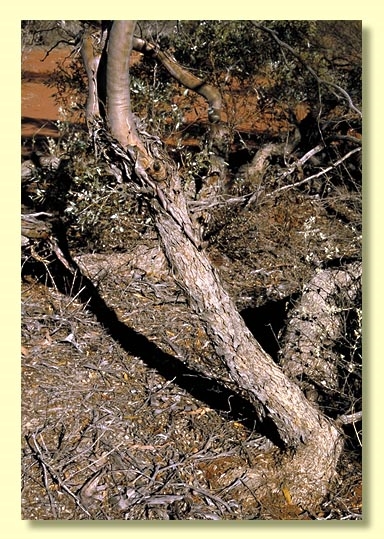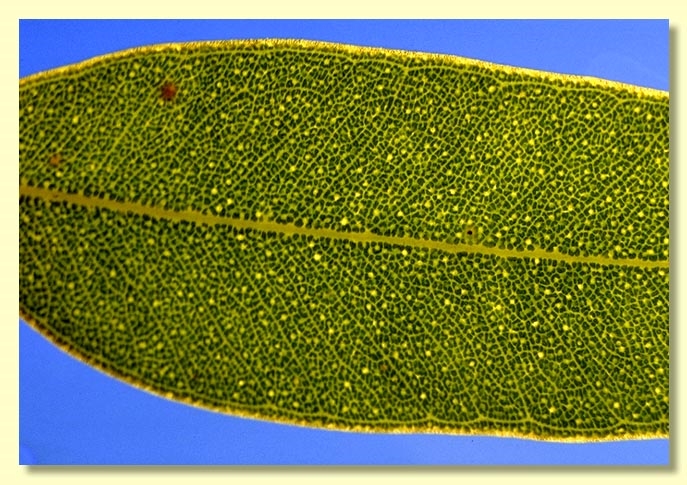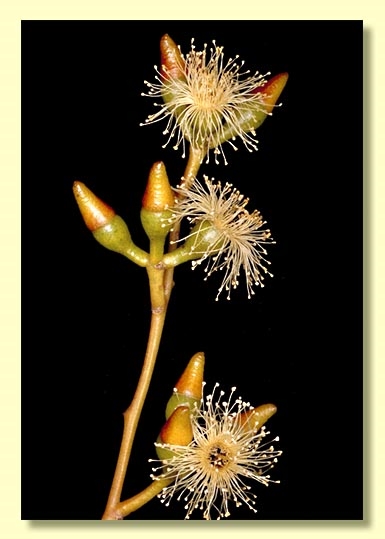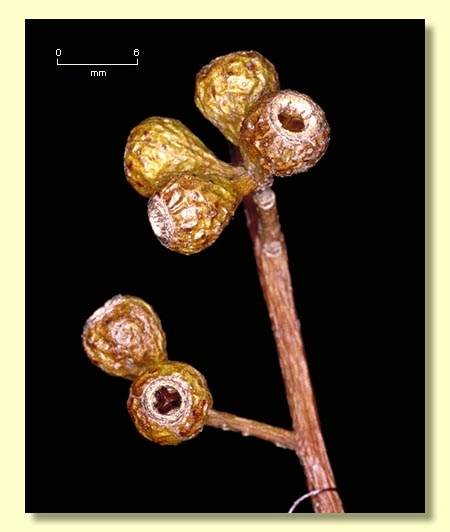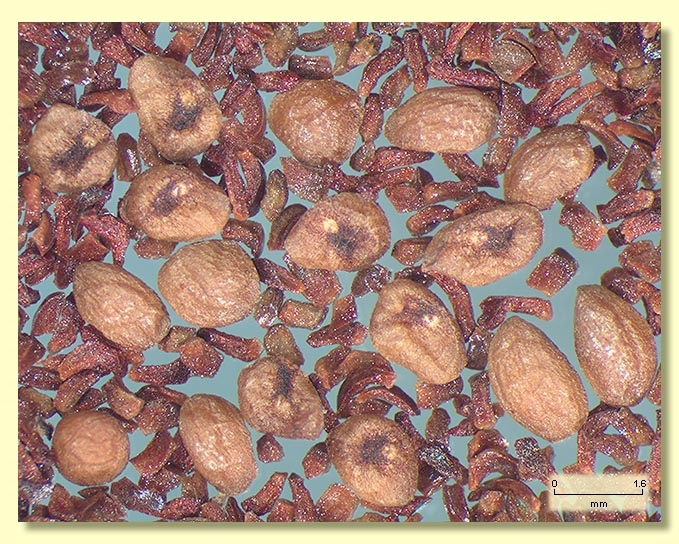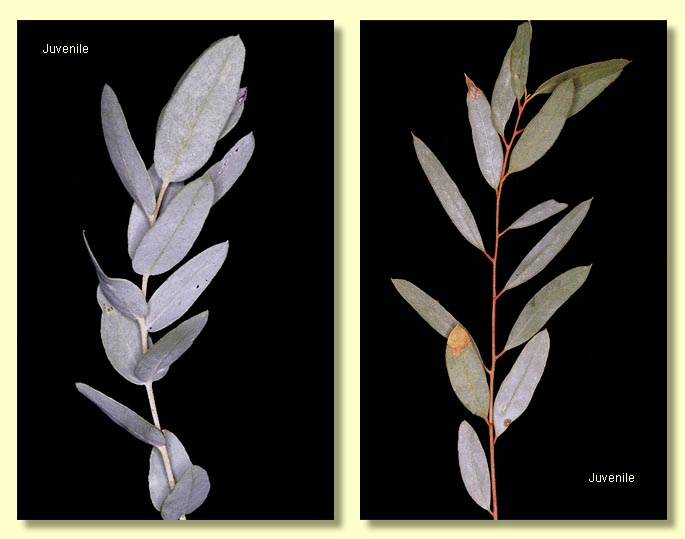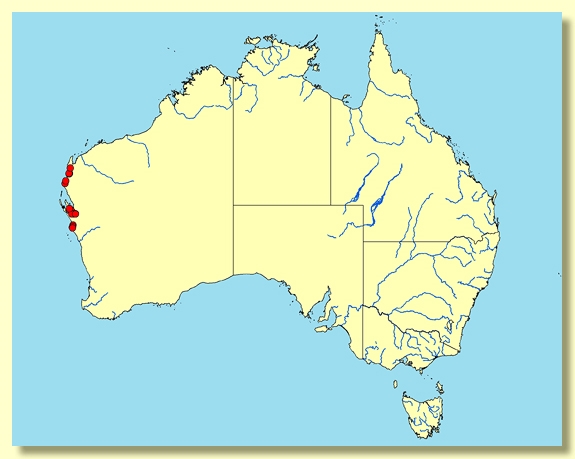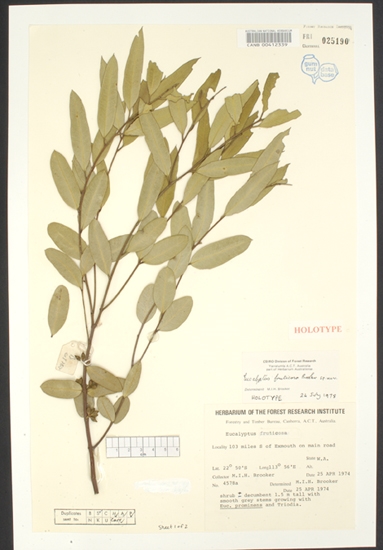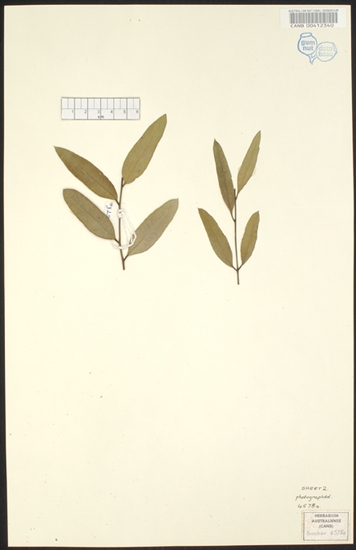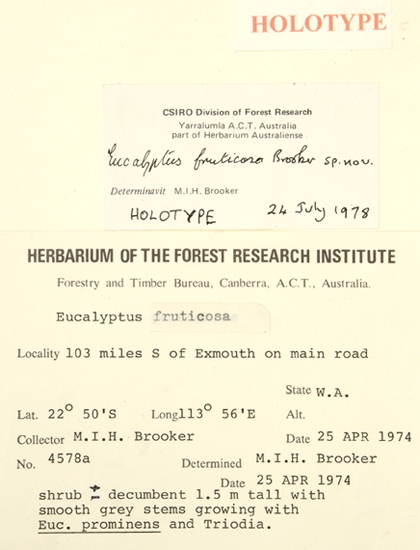Eucalyptus | Symphyomyrtus | Bisectae | Destitutae | Porantherae | Ovatae
Euclid - Online edition
Eucalyptus fruticosa
Bark rough over part or all of the stems sometimes extending to branches to ca 8 cm diameter, fibrous to flaky, grey-brown, smooth above pale tan and grey-brown, shedding in ribbons, but smaller mallees may be smooth-barked.
Branchlets lacking oil glands in the pith.
Juvenile growth (coppice or field seedlings to 50 cm): stems rounded in cross-section, glaucous; juvenile leaves opposite or less commonly sub-opposite, cordate to elliptic-oblong, 1.2–6 cm long, 0.8–1.5 cm wide, bases amplexicaul to rounded, glaucous weathering to grey-green.
Crown consisting of a variable mixture of juvenile leaves and true adult leaves.
Adult leaves alternate, petioles to 1.3 cm long; blade linear to narrowly lanceolate or narrowly elliptic, 3–8 cm long, 0.7–1.7 cm wide, base tapering to petiole, margin entire, apex pointed, concolorous, glossy, green, side-veins greater than 45° to midrib, reticulation dense, intramarginal vein present, oil glands numerous, irregular to round, intersectional.
Inflorescence axillary unbranched, peduncles round to angular, 0.4–1 cm long, buds (?7), 9 or 11 per umbel, pedicels 0.1–0.3 cm long. Mature buds ovoid to fusiform (0.7–1 cm long, 0.3–0.4 cm wide), scar present, operculum beaked to conical (0.3–0.5 cm long), stamens mostly inflexed (a few may be irregularly flexed), anthers cuneate-cuboid, adnate to filament apex (rigidly basifixed), dehiscing by sub-terminal pores, a few of the innermost stamens imperfectly formed, style long and straight or slightly but conspicuously twisted apically, stigma tapered, locules 3, the placentae each with 4 vertical rows of ovules. Flowers creamy white.
Fruit pedicellate (pedicels 0–0.3 cm long), shortly barrel-shaped to truncate-globose, 0.4–0.8 cm long, 0.5–0.6 cm wide, disc descending, valves 3, near rim level.
Seeds brown to grey-brown, 1–2 mm long, flattened-ovoid, dorsal surface sometimes with longitudinal furrows, smooth, hilum ventral.
Cultivated seedlings (measured at node 10): cotyledons Y-shaped (bisected); stems rounded in cross-section, usually glaucous, conspicuously warty; leaves sessile and opposite for at least 20 nodes, the pairs of leaves well spaced, cordate, 2–4 cm long, 2–3 cm wide, bases amplexicaul, glaucous on both surfaces or much more so below and greener above.
Flowering has been recorded in May.
A low, often sprawling mallee endemic to Western Australia, occurring from Kalbarri north to Coburn, Shark Bay, Gnaraloo and Waroora on limy red sands. Larger mallees have rough bark on the stems and limbs. It is a coastal arid zone species conspicuous because of the crown of mixed and contrasting glossy, green, lanceolate adult and glaucous, cordate to elliptic juvenile leaves.
Eucalyptus fruticosa belongs in Eucalyptus subgenus Symphyomyrtus section Bisectae subsection Destitutae because the buds have two opercula, cotyledons are Y-shaped and branchlets lack oil glands in the pith. Within this subsection E. fruticosa belongs to a group of about 16 species, series Porantherae, that are further characterised by having anthers completely adnate to the staminal filaments, strongly inflexed stamens, densely reticulate leaves with intersectional oil glands and the fruit with a distinct thick rim that includes a whitish descending disc. The small, glossy leaves of species in series Porantherae may result in confusion with species in series Heterostemones; however, the fruit alone usually distinguish the series. The fruit of series Heterostemones are thin-rimmed.
Eucalyptus fruticosa is morphologically close to E. horistes, which is a mallee or erect tree of more inland distribution and with a crown entirely of adult leaves. The two species differ from the only other two west coastal species of series Porantherae, namely E. foecunda, which is an erect mallee with lanceolate, green juvenile leaves; and E. sp. Kalbarri, an undescribed species from the Murchison River area, which has larger, more barrel-shaped fruit and green, more or less ovate juvenile leaves.


